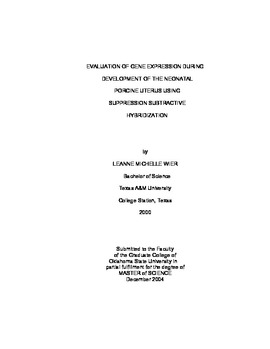| dc.description.abstract | Specific changes in gene expression involved in the completion of uterine gland development during the first 56 days of postnatal growth in the pig have not been well described or understood. The present work utilized suppression subtractive hybridization (SSH) to create unique cDNA libraries respective to postnatal development at 3 stages: Day 0 when only shallow depressions can be observed, Day 28 when branching morphogenesis begins, and Day 56 when glands are well established. A total of 288 SSH products were screened in two forward and reverse reactions. Of these, 67 were identified to be differentially expressed through dot-blot hybridization assays using DIG-labeled probes. Only 34 were subjected to sequencing and BLAST analysis. Sequence analysis revealed 25/34 quality readings and 16/25 matched known sequences, while 7/25 returned identity to uncharacterized clones, and 2/25 had no significant match to any known sequences. Comparison of PND 0 with PND 28 showed genes in the forward subtraction represent those involved in transcription or translation, including elongation factor 1 alpha 1 (EF1a1), poly(A) binding protein, cytoplasmic 1 (PABPC1), and polymerase (RNA) II (DNA directed) polypeptide C (POLR2C / RPB3). One other gene of interest found was secreted protein, acidic, cysteine-rich-like 1 (SPARCL1) which influences several cellular activities including proliferation, migration, and differentiation. Gene products that had greater expression at Day 28 than Day 0 included type II procollagen (COL1A2) and type III procollagen (COL3A1) which are important in tissue structure. Also identified in the reverse subtraction was a clone with strong similarity to human 40S, which may indicate a gene that contributes to the control of cell growth and proliferation. The PND 28 versus PND 56 comparison resulted in fewer differentially expressed genes and only one novel gene was detected. Quantitative real-time PCR (qRT-PCT) assays were performed for SPARCL1 and two uncharacterized clones. Expression levels for all three transcripts evaluated showed a similar pattern of high levels at PND 0 and 14, then declining to normalized values at PND 28, 42, and 56. Therefore, we conclude that the factors responsible for the initiation of uterine glands are activated at birth, when only buds are present, through PND 14, when glands are forming tubes. These high levels of different transcripts may serve to regulate glandular epithelium migration through the stroma during glandular budding and tubulogenesis. | |
